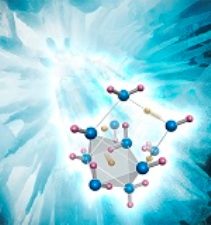Jun 11 2013
Using revolutionary new techniques, a team led by Carnegie’s Malcolm Guthrie has made a striking discovery about how ice behaves under pressure, changing ideas that date back almost 50 years. Their findings could alter our understanding of how the water molecule responds to conditions found deep within planets and could have implications for energy science. Their work is published in the Proceedings of the National Academy of Sciences.
 A fragment of the crystal structure of the new ice is shown where the oxygen atoms are blue and the molecular hydrogen atoms pink. Hydrogen atoms that have been pulled off the water molecules are colored gold. These appear to locate in polyhedral voids in the oxygen lattice (one of which is shaded light grey). Previously, these voids were believed to remain even after the water molecule breaks up at enormous pressures. Image is provided courtesy of Oak Ridge National Laboratory.
A fragment of the crystal structure of the new ice is shown where the oxygen atoms are blue and the molecular hydrogen atoms pink. Hydrogen atoms that have been pulled off the water molecules are colored gold. These appear to locate in polyhedral voids in the oxygen lattice (one of which is shaded light grey). Previously, these voids were believed to remain even after the water molecule breaks up at enormous pressures. Image is provided courtesy of Oak Ridge National Laboratory.
When water freezes into ice, its molecules are bound together in a crystalline lattice held together by hydrogen bonds. Hydrogen bonds are highly versatile and, as a result, crystalline ice reveals a striking diversity of at least 16 different structures.
In all of these forms of ice, the simple H2O molecule is the universal building block. However, in 1964 it was predicted that, under sufficient pressure, the hydrogen bonds could strengthen to the point where they might actually break the water molecule apart. The possibility of directly observing a disassociated water molecule in ice has proven a fascinating lure for scientists and has driven extensive research for the last 50 years. In the mid-1990s several teams, including a Carnegie group, observed the transition using spectroscopic techniques. However, these techniques are indirect and could only reveal part of the picture.
A preferred method is to “see” the hydrogen atoms–or protons–directly. This can be done by bouncing neutrons off the ice and then carefully measuring how they are scattered. However, applying this technique at high enough pressures to see the water molecule dissociate had simply not been possible in the past. Guthrie explained that: “you can only reach these extreme pressures if your samples of ice are really small. But, unfortunately, this makes the hydrogen atoms very hard to see.”
The Spallation Neutron Source was opened at Oak Ridge National Laboratory in Tennessee in 2006, providing a new and intensely bright supply of neutrons. By designing a new class of tools that were optimized to exploit this unrivalled flux of neutrons, Guthrie and his team–Carnegie’s Russell Hemley, Reinhard Boehler, and Kuo Li, as well as Chris Tulk, Jamie Molaison, and António dos Santos of Oak Ridge National Laboratory–have obtained the first glimpse of the hydrogen atoms themselves in ice at unprecedented pressures of over 500,000 times atmospheric pressure.
“The neutrons tell us a story that the other techniques could not,” said Hemley, director of Carnegie’s Geophysical Laboratory. “The results indicate that dissociation of water molecules follows two different mechanisms. Some of the molecules begin to dissociate at much lower pressures and via a different path than was predicted in the classic 1964 paper.”
“Our data paint an altogether new picture of ice,” Guthrie commented. “Not only do the results have broad consequences for understanding bonding in H2O, the observations may also support a previously proposed theory that the protons in ice in planetary interiors can be mobile even while the ice remains solid.”
And this startling discovery may prove to be just the beginning of scientific discovery. Tulk emphasized “being able to ‘see’ hydrogen with neutrons isn’t just important for studies of ice. This is a game-changing technical breakthrough. The applications could extend to systems that are critical to societal challenges, such as energy. For example, the technique can yield greater understanding of methane-containing clathrate hydrates and even hydrogen storage materials that could one day power automobiles”.
The group is part of Energy Frontier Research in Extreme Environments (EFree), an Energy Frontier Research Center headquartered at Carnegie’s Geophysical Laboratory.